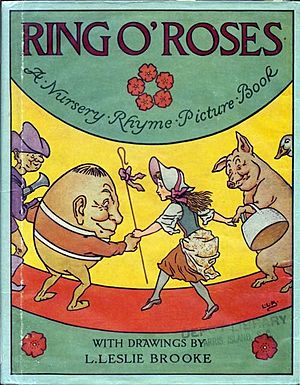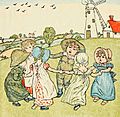Ring a Ring o' Roses facts for kids
Quick facts for kids "Ring a Ring o' Roses" |
|
|---|---|
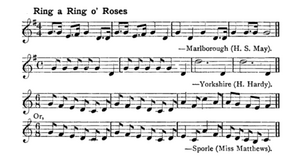
Musical variations of '"Ring a Ring o' Roses", Alice Gomme, 1898.
|
|
| Nursery rhyme | |
| Published | 1881 |
| Audio samples
|
|
"Ring a Ring o' Roses" or "Ring Around the Rosie" or "Ring a Ring o' Rosie" is a nursery rhyme or folksong and playground singing game. It first appeared in print in 1881, but it is reported that a version was already being sung to the current tune in the 1790s and similar rhymes are known from across Europe. It has a Roud Folk Song Index number of 7925.
Contents
Lyrics
It is unknown what the earliest version of the rhyme was or when it began. Many incarnations of the game have a group of children form a ring, dance in a circle around a person, and stoop or curtsy with the final line. The slowest child to do so is faced with a penalty or becomes the "rosie" (literally: rose tree) from the French rosier) and takes their place in the center of the ring.
Variations, corruptions, and vulgarized versions were noted to be in use long before the earliest printed publications. One such variation was dated to be in use in Connecticut in the 1840s.
Common British versions include:
Ring-a-ring o' roses,
A pocket full of posies,
A-tishoo! A-tishoo!
We all fall down.
Cows in the meadows
Eating buttercups
A-tishoo! A-tishoo!
We all jump up.
Common American versions include:
Ring-a-round the rosie,
A pocket full of posies,
Ashes! Ashes!
We all fall down.
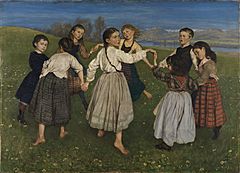
The last two lines are sometimes varied to:
Hush! Hush! Hush! Hush!
We've all tumbled down.
The Indian version of the poem is:
Ringa ringa roses,
Pocket full of poses,
Hush-sha bush-sha,
All fall down.
Other languages
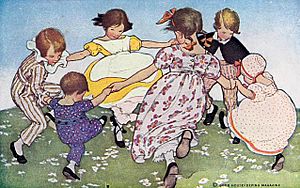
A German rhyme first printed in 1796 closely resembles "Ring a ring o'roses" in its first stanza and accompanies the same actions (with sitting rather than falling as the concluding action):
Ringel ringel reihen,
Wir sind der Kinder dreien,
sitzen unter'm Hollerbusch
Und machen alle Husch husch husch!
Loosely translated this says "Ringed, ringed row. We are three children, sitting under an elder bush. All of us going hush, hush, hush!" The rhyme is well known in Germany with the first line "Ringel, Ringel, Reihe" (as the popular collection Des Knaben Wunderhorn gave it); it has many local variants, often with "Husch, husch, husch" (which in German could mean "quick, quick") in the fourth line, comparable to the "Hush! hush! hush! hush!" of the first printed English version. This popular variant is notable:
Ringel, Ringel, Rosen,
Schöne Aprikosen,
Veilchen blau, Vergissmeinnicht,
Alle Kinder setzen sich!
The translation is "A ring, a ring of roses. Beautiful apricots. Blue violets, forget-me-nots. All children sit down."
Swiss versions have the children dancing round a rosebush. Other European singing games with a strong resemblance include "Roze, roze, meie" ("Rose, rose, May") from The Netherlands with a similar tune to "Ring a ring o' roses" and "Gira, gira rosa" ("Circle, circle, rose"), recorded in Venice in 1874, in which girls danced around the girl in the middle who skipped and curtsied as demanded by the verses and at the end kissed the one she liked best, so choosing her for the middle.
In Croatian/Serbian/Bosnian language, there is a similar rhyme called "Ringe Ringe Raja":
Ringe-ringe-raja,
Doš'o čika Paja,
Pa pojeo jaja.
Jedno jaje muć,
A mi, djeco, ČUČ!
A rough translation is "Ringe Ringe Raya (doesn't mean anything, this is common in Croato-Serbian rhymes), uncle Ducky has came, and he ate all the eggs, one egg crashed, and we children DUCK!" On the last word, the children singing the rhyme jump or duck.
Images for kids
-
Kate Greenaway's illustration from Mother Goose or the Old Nursery Rhymes (1881)
See also
 In Spanish: Corro de la patata para niños
In Spanish: Corro de la patata para niños


